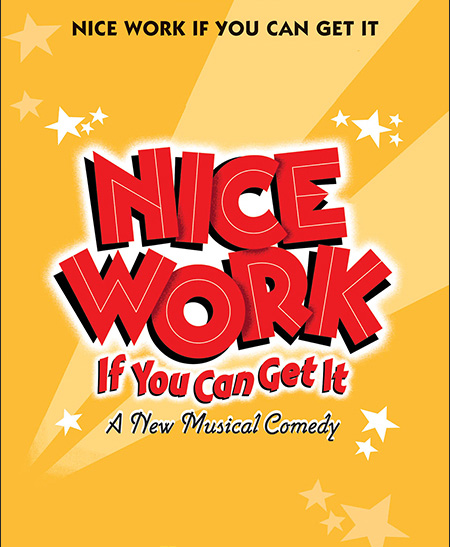
Stage Two’s Nice Work If You Can Get It is the musical I’ve been longing for all year; although about the 2-hour mark I stopped longing and started yawning, with 45 minutes of wrap-up and reprises to go. Still, it was a grin-filled, charming evening, borne effortlessly on the singing, dancing, wisecracking shoulders of Megan Breit and Eddie Rose. Breit and Rose were born decades after the golden age of screwball comedy, but it must be in their genes, or maybe they were inhabited by some kind of theatrical spirit. Nice work, indeed.
Nice Work If You Can Get It continues the venerable tradition of re-packaging material by a composer or songwriting team, often from other musicals. There is always a sense of déjà vu, which isn’t necessarily bad: at best, these shows are tasty confections. Nice Work… spent a decade in development before it opened on Broadway in 2012. The songs, by George and Ira Gershwin, are a veritable greatest hits of popular song from almost a century ago. They don’t always dovetail with Joe DiPietro’s book, a serviceable farce about a playboy, a gaggle of chorus girls, a (bad) modern dance star, and a trio of hapless bootleggers set during the heyday of Prohibition.
The fact that we know these songs well makes things difficult for the performers, who are often singing out of their ranges, against our memories of Sinatra, Fitzgerald and other greats. With that in mind, the songs were better than I expected, and this production occasionally brought the material to exciting new life. If that seems like faint praise, keep in mind the difficulty of the task at hand (there’s a reason the show was in development hell for years.) Stage Two’s singers were well prepared by music director John Krause, and supported by a crack pit band, conducted by Mark A. Bunce.
Catherine Daly’s direction maintained a brisk pace for most of the show, until the material itself slowed things to a crawl (several songs and reprises might have been trimmed by the show’s creators.) A high percentage of jokes landed smartly, and the cast appeared to be enjoying themselves while playing everything out to the audience. (Not as easy as it sounds – many companies have their fun at the expense of ticket buyers.)
Megan Breit was fabulous as Billie Bendix, the bootlegger who falls for the playboy. Breit is tiny but moves and emotes with precision – every facial expression reads huge, unfailingly mining the material for every possible laugh and smile. She struck gold in her number Treat Me Rough, executing the most inept and hilarious seduction ever. Christina D’Amico’s choreography, inventive and overflowing throughout the show, was just about perfect here, sending up every move in the playbook (as Billie says, “female stuff.”) Performer and choreographer worked so far above and beyond the material, I wouldn’t have minded a few reprises of just this number – don’t change a thing, I wanted it again and again.
As Cookie McGee, Eddie Rose wasn’t as solid as Breit vocally, but he made up for that with energy and comic timing (he’s a good dancer, too.) It was smart not to romantically pair his character with Breit, as many directors might have done. Because they shared few scenes, we got to see one or the other throughout the show. Ally Priore had some very funny moments as Eileen Evergreen, especially when she was “dancing badly” (her character is supposed to be the world’s preeminent “interpretive dancer” – D’Amico had a great time setting up intentionally bad dances for this show.) In a sense, Priore was too endearing – she risked shifting audience sympathy away from the show’s inevitable romantic coupling. Another highlight was Priore’s number Delishious, delightfully staged so the chorus girls emerged from her bubbling bathtub.
Tino Laterza was an amiable host as the playboy – he sang well, and convinced us he wasn’t into the whole “work” concept. In that sense, it’s a somewhat thankless role – the material requires him to cede the spotlight, which Laterza does graciously. Supporting players Michael Stalteri, Michael Clark, Danielle Piazza, Rachel Nunneker, Sean Gallagher and Kathryn Trombley were all on the same page, and generated satisfying laughs in turn. The ensemble was game for Gershwin’s music and D’Amico’s dances – lots of song and dance, none of it easy.
The sets and costumes were a throwback to old Broadway shows with budget to burn – it was great seeing the different locations and seemingly endless outfits. Set changes were so brisk the curtains were still swaying as the lights came back up – the only way they could have improved would have been to do them in full blackout (a holy grail not usually possible.) Lighting and sound were basic and un-distracting, often the best one can hope for in a high school auditorium.
I wondered if my warm goodwill would have extended to this production on a professional stage – I think it would have, but it’s worth thinking about. We’ve all gone to high school shows with reduced expectations and because of that have been surprised and delighted by what the teens pull off. This Stage Two troupe was young – the median age might have been 18. Part of my enjoyment of the show was certainly because I like watching young performers engage difficult material. I think the Herkimer HS auditorium offered the ideal ambience for this company to shine.
This was the first Stage Two production I’ve attended in many years. I liked almost everything, and seriously loved some of it. Later, turning over what I’d seen, what lingered was Breit, Rose and D’Amico. I want to see a LOT more of these three. Remember their names.

